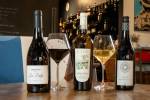Need help buying wine gifts this season?
If you’re thinking of giving a gift of wine for the holidays, it might be wise to go with the overriding theme of the season and choose one that sparkles.
“Bubbles are always popular,” said Thomas Ratcliff, director of wine for The Cosmopolitan of Las Vegas. “I love sparkling wine. It kind of sets the tone; it’s very festive.”
First, remember there’s a difference between sparkling wine and Champagne.
“You can get really good sparkling wines all over the world,” he said, “but there’s only one Champagne,” and that’s from the Champagne region of France.
Ratcliff and other local wine experts said a trend among wine lovers is away from famous names and toward small-grower Champagnes.
“Everybody knows the big brands,” said Mark Hefter, wine director and sommelier for La Cave at Wynn Las Vegas. “It’s always safe to give somebody a bottle of Dom or Krug, but there’s a lot of small-grower stuff out there.”
“It’s suddenly hip to seek out these estate Champagnes,” said Henry Davar, business development manager for Wirtz Beverage Nevada.
Davar said the category of growers’ Champagne started 15 or 20 years ago with 1 percent of the market and has grown to 5 percent.
“It’s made by the farmer who grows the grapes, an estate product,” he said.
Hefter said one importer refers to such Champagnes as “farmer fizz.” Hefter likes one made by Charles de Cazanove, a producer in Reims, France.
Ratcliff likes Pierre, which specializes in blanc de blanc Champagnes, and Billecart-Salmon.
“Their rose is probably what they’re best known for, and it’s delicious,” he said of the latter.
Davar said he likes Pierre Gimonnet and Henri Goutorbe.
“We’re not talking hundreds of dollars,” he said, “we’re talking, on a retail shelf, about $100. And it’s something that’s unique and thoughtful.”
As seems fitting, Davar said some of the smaller local retailers are good sources for growers’ Champagnes.
“I think the best place to look currently is a retailer like Bob over at Valley Cheese and Wine, who’s always searching out French products that people don’t know about,” he said. “Khoury’s does a good job of mixing a little bit of fringe elements with more user-friendly wines. Another is always Marche Bacchus.”
But while Champagne is widely (and sometimes wildly) popular, it does have its detractors, and the experts have other suggestions.
“This time of year you see a lot of Beaujolais Nouveau, which was just released,” Ratcliff said. “I like cru Beaujolais. There are 10 crus, which are area-specific. It works well with all of the holiday foods you have, like turkey. It’s not as heavy as a pinot noir.”
And Hefter likes gifts with a back story.
“It’s always fun to give somebody something you can get a little bit of background information on, tell them a little bit of a story about it,” he said.
“One of the things I love is Madeira. It’s perfect for the desserts of the season — if you want to call fruitcake a dessert, but like stollen, a lot of rich desserts.
“The really good thing about Madeira is you can find something from the 19th century that costs $250 to $300, unbelievably memorable but still within a decent budget.”
Even if your budget’s not that decent, Madeira may be the way to go.
“Blandy’s Alvada is a 5-year-old Madeira, but they blend two of the four major grapes, which is almost never done,” Hefter said. “I really love that one because it sort of has one foot in the super-classic version of Madeira and the other in modern winemaking style.”
And it retails, he noted, for $20 to $25.
“Just that price range alone shows you can find anything,” he said.
And now the back story: Hefter said the island of Madeira, which is off Portugal, was burned to the ground by a pirate in search of his treasure.
“What that did was decimate the entire island, but make the soil super, super fertile, and it makes it a really great area for winegrowing,” he said.
But wait! There’s more.
“Sort of like some of our greatest achievements, penicillin and others, it completely happened by mistake,” he said.
It seems the Madeira wine that was being made was dry. But then it was shipped all over the globe, on rocking ships with no temperature, humidity or other controls.
“That basically turned it into Madeira by the time it reached the port,” he said. The winemakers had no idea — until a ship was forced to turn back with a load, and they tasted the returning barrels.
“It’s now made by basically duplicating that process,” he said. “As a gift, it never goes bad, because everything bad’s already happened to it. You can leave it out for months and it’ll still be OK.”
Ratcliff added he also likes to gift Italian wines.
“When you think about the United States and winemaking here, there’s like four states that are really doing anything of consequence,” he said. “And then you think about Italy: There’s 20 states, and all 20 make wine that’s really worth it. To me, Italian wine is food wine, and for this season, that’s what you want to have on the table.”
While Ratcliff said it’s easier to select a gift of wine if you know what the person likes, Patrick Liedtke, sommelier for the Liquor Library at McCarran International Airport, said you can also take a generalized approach.
“First of all, you want to go for a wine that’s not overcomplicated when you’re gifting, because you really don’t know what people like,” he said. “Wine is a lot like food. Not everybody likes Brussels sprouts. You might like this weird wine, but not everybody else does. You want to find a wine that’s easy to drink and is not going to break the bank.”
In reds, that tends to mean malbec and merlot, which he said are “crowd-pleasers, easy to drink.” In whites, he suggests chardonnay, but not one that’s overly buttery.
And consider riesling.
“In the wine world, we call it the king of wines, because it goes with everything; you can’t go wrong,” he said. “One misconception of riesling is that it’s too sweet. You can buy riesling that’s not so sweet, even dry. People are surprised, they’re trying to look for that sugary aspect.
“Pinot noir is really good, too. California, because it’s heavier than its French counterparts, can pair with fish or meat, goes great with ham and goes great with turkey.”
Above all, Liedtke said, don’t overthink your wine-giving.
“Keep it simple, not overbearing,” he said. “Find that middle ground and make people happy.”
Contact reporter Heidi Knapp Rinella at hrinella@reviewjournal.com or 702-383-0474.





























